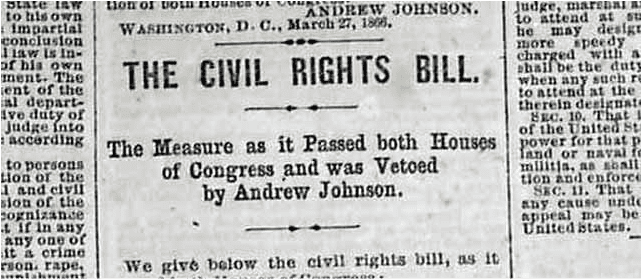By William H. Benson
The Parallel Lives
Of The NOBLE AMERICAN RELIGIOUS THINKERS AND BELIEVERS:
Roger Williams VS. Cotton Mathers
NEW ARTICLES

Black History Month: Reconstruction, 1865-1866
In December of 1863, in the midst of the Civil War, President Abraham Lincoln suggested a plan to reinstate the seceded states back into the Union, his “Ten Percent Plan.”
He would permit each Confederate state to form a new state government after ten percent of the voters in a state took loyalty oaths to the Union and recognized the former slaves’ freedom.
Following Lincoln’s assassination on April 9, 1865, his successor, former Vice-President Andrew Johnson, decided to run with Lincoln’s Ten Percent Plan.
Throughout the summer and fall of 1866, the Southern states held special state conventions. At them, they repealed secession, repudiated all Confederate debts, ratified the 13th Amendment that outlawed slavery, and held elections, all in accord with the Ten Percent Plan.
Those elected to various offices in these new state governments included: four former Confederate generals, five colonels, members of the Confederate government’s cabinet, plus Alexander Stephens, the Confederacy’s former Vice-President, who was indicted for treason.
President Johnson felt embarrassed that a series of former Confederates were back in power.
The one constant in these new state governments was their utter contempt for the former slaves, whom they considered “unfit, “inferior,” and “incapable of self-government.”
The new state governments passed a series of Black Codes, designed to keep the former slave poor, stuck at the bottom of the social ladder, with no opportunity for advancement.
Vagrancy laws within the Black Codes forced blacks into contracted labor on a plantation’s fields. Also, the Black Codes denied the former slaves equal protection under the law.
The former slaves convened at their own conventions, called Colored Conventions. At them, delegates discussed “labor, health care, temperance, emigration, voting rights, trial by jury, and education.” Anyone can read the convention’s minutes at the “Colored Conventions Project.”
On December 4, 1865, when the Thirty-Ninth Congress first convened in Washington D.C., Northern Republicans were dismayed to see former Confederates try to walk into the Capitol and assume a seat. They slammed the door in their faces, and Congress’s clerk refused to seat them.
They were called names: “impudent claimants,” “unrepentant,” and “former enemies.”
Thaddeus Stevens, a Republican in the House,” said, “Dead states cannot restore their existence. Congress must create states and declare when they are entitled to be represented.”
Both Presidential and Confederate Reconstruction had ended, but now Congressional Reconstruction was set to begin. A “spirit of revenge” motived these Radical Republicans to act.
On Dec. 13, 1865, Congress formed a Joint Committee of Fifteen on Reconstruction, composed of nine Representatives and six Senators to investigate and determine under what terms the seceded states might regain their status as a state, plus congressional representation.
The committee interviewed “144 witnesses, including 77 Northerners living in the South, 8 Blacks, and 57 Southerners,” and produced “more than 700 pages of testimony, a dreary recital of inhumanity,” of how whites mistreated the former slaves throughout the Southern states.
The committee first recommended further support for the Freedmen’s Bureau, intended to provide relief, food, and schools for the blacks. It also recommended a civil rights bill.
On April 9, 1866, Congress passed the Civil Rights Act of 1866, by a two-thirds vote over President Johnson’s veto. It declared that “all persons born in the United States were citizens,” “without distinction of race or color or previous condition of slavery or involuntary servitude.”
This Act was unique, the first United States federal law to define what persons are citizens.
Black History Month ends this week.
Reconstruction is a messy history. Some consider it a low point in American history. Others, including Eric Foner, historian at Columbia University, label it our nation’s “Second Founding.”
More next time on Reconstruction in these pages, thoughts on the 14th Amendment.
March Madness
March MadnessMarch Madness by William H. Benson March 24, 2016 The NCAA basketball games are upon us, and March Madness has arrived. The team to watch in recent years has been the University of Connecticut, where basketball is king. The men won their last...
Thoughts on Campaign 2016
Thoughts on Campaign 2016Thoughts on Campaign 2016 by William H. Benson March 10, 2016 The United States has had two father-son presidencies. The first was John Adams and his son, John Quincy Adams, and the second was George Bush and his son, George W. Bush....
“Feelings in History”
“Feelings in History”“Feelings in History” by William H. Benson February 25, 2016 Scientists want to quantify. First, they observe a phenomenon, record their observations, arrive at a set of numbers, and then build a hypothesis. This procedure—the scientific...
Presidents Day
Presidents DayPresidents Day by William H. Benson February 11, 2016 In September of 1796, President George Washington published a remarkable document, his Farewell Address “to the People of the United States on his declining of the Presidency.” After two...
“We Are the World” and Benghazi
“We Are the World” and Benghazi“We Are the World” and Benghazi by William H. Benson January 28, 2016 Late in 1984, the calypso singer Harry Belafonte decided to raise funds for the famine-starved Ethiopians in Africa. First, he approached Michael Jackson and...
American Divisiveness
American DivisivenessAmerican Divisiveness by William H. Benson January 14, 2016 Last month in Newsweek, a columnist named Kurt Eichenwald made a series of startling statements about the bitter divisiveness that separates Democrats and Republicans. He was...
Older Posts
Story and Myth
Story and MythStory and Myth by William H. Benson December 31, 2015 An article appeared in the New York Times two weeks ago, “Jane Austen's Guide to Alzheimer's.” In it, Carol J. Adams described her difficult days caring for her mother, who had lost the battle to...
Love Story
Love StoryLove Story by William H. Benson December 17, 2015 “What can you say about a twenty-five-year-old girl who died? That she was beautiful. And brilliant. That she loved Mozart and Bach. And the Beatles. And me.” So begins Oliver Barrett IV in Erich Segal's...
Lebanon’s Civil War
Lebanon's Civil WarLebanon's Civil War by William H. Benson December 3, 2015 In the book, The Black Swan: The Impact of the Highly Improbable, the book's author Nassim Nicholas Taleb describes the people in Lebanon, his native country. It was, he writes, “an...
China’s One-Child Policy
China's One-Child PolicyChina's One-Child Policy by William H. Benson November 5, 2015 The Chinese people felt an immediate sense of relief last Thursday when their government stated that it will permit married couples now to have two children. The government's...
Bobby Fischer and Steve Jobs
Bobby Fischer and Steve JobsBobby Fischer and Steve Jobs by William H. Benson October 22, 2015 Hollywood just released two biographical movies. The first was on Bobby Fischer entitled Pawn Sacrifice, and the other was on Steve Jobs, entitled Steve Jobs. Bobby's...
Mel Blanc: Comedy and Tragedy
Mel Blanc: Comedy and TragedyMel Blanc: Comedy and Tragedy by William H. Benson October 8, 2015 Mel Blanc was known as “the man with a thousand voices” because he created voices for numerous cartoon characters. For Warner Brothers, Mel was the voice of Wile...

One of University of Northern Colorado’s 2020 Honored Alumni
William H. Benson
Local has provided scholarships for history students for 15 years
A Sterling resident is among five alumni selected to be recognized this year by the University of Northern Colorado. Bill Benson is one of college’s 2020 Honored Alumni.
Each year UNC honors alumni in recognition for their outstanding contributions to the college, their profession and their community. This year’s honorees were to be recognized at an awards ceremony on March 27, but due to the COVID-19 outbreak that event has been cancelled. Instead UNC will recognize the honorees in the fall during homecoming Oct. 10 and 11……
Newspaper Columns
The Duodecimal System
For centuries, the ancient Romans calculated sums with their clunky numerals: I, V, X, L, C, D, and M; or one, five, ten, 50, 100, 500, and 1,000. They knew nothing better.
The Thirteenth Amendment
On Jan. 1, 1863, President Abraham Lincoln signed the Emancipation Proclamation, and by it, he declared that “all persons held as slaves” within the rebellious states “are and henceforward shall be free.” Lincoln’s Proclamation freed some 3.1 million slaves within the Confederacy.
The Fourteenth Amendment
After Congress and enough states ratified the thirteenth amendment that terminated slavery, Congress passed the Civil Rights Act of 1866. This law declared that “all people born in the United States are entitled to be citizens, without regard to race, color, or previous condition of slavery or involuntary servitude.” The Act equated birth to citizenship.
The New-York Packet and the Constitution
Jill Lepore, the Harvard historian, published her newest book a month ago, These Truths: A History of the United States. In a short introduction, she describes in detail the Oct. 30, 1787 edition of a semi-weekly newspaper, The New-York Packet.
Mr. Benson’s writings on the U.S. Constitution are a great addition to the South Platte Sentinel. Its inspiring to see the history of the highest laws of this country passed on to others.
– Richard Hogan
Mr. Benson, I cannot thank you enough for this scholarship. As a first-generation college student, the prospect of finding a way to afford college is a very daunting one. Thanks to your generous donation, my dream of attending UNC and continuing my success here is far more achievable
– Cedric Sage Nixon
Donec bibendum tortor non vestibulum dapibus. Cras id tempor risus. Curabitur eu dui pellentesque, pharetra purus viverra.
– Extra Times
FUTURE BOOKS
- Thomas Paine vs. George Whitefield
- Ralph Waldo Emerson vs. Joseph Smith
- William James vs. Mary Baker Eddy
- Mark Twain vs. Billy Graham
- Henry Louis Mencken vs. Jim Bakker






